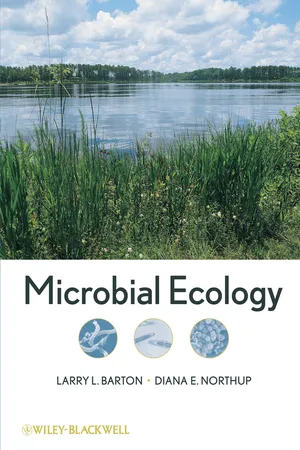
- English
- ePUB (mobile friendly)
- Available on iOS & Android
Microbial Ecology
About this book
In thirteen concise and timely chapters, Microbial Ecology presents a broad overview of this rapidly growing field, explaining the basic principles in an easy-to-follow manner. Using an integrative approach, it comprehensively covers traditional issues in ecology as well as cutting-edge content at the intersection of ecology, microbiology, environmental science and engineering, and molecular biology.
Examining the microbial characteristics that enable microbes to grow in different environments, the book provides insights into relevant methodologies for characterization of microorganisms in the environment. The authors draw upon their extensive experience in teaching microbiology to address the latest hot-button topics in the field, such as:
- Ecology of microorganisms in natural and engineered environments
- Advances in molecular-based understanding of microbial phylogeny and interactions
- Microbially driven biogeochemical processes and interactions among microbial populations and communities
- Microbial activities in extreme or unusual environments
- Ecological studies pertaining to animal, plant, and insect microbiology
- Microbial processes and interactions associated with environmental pollution
Designed for use in teaching, Microbial Ecology offers numerous special features to aid both students and instructors, including:
- Information boxes that highlight key microbial ecology issues
- "Microbial Spotlights" that focus on how prominent microbial ecologists became interested in microbial ecology
- Examples that illustrate the role of bacterial interaction with humans
- Exercises to promote critical thinking
- Selected reading lists
- Chapter summaries and review questions for class discussion
Various microbial interactions and community structures are presented through examples and illustrations. Also included are mini case studies that address activities of microorganisms in specific environments, as well as a glossary and key words. All these features make this an ideal textbook for graduate or upper-level undergraduate students in biology, microbiology, ecology, or environmental science. It also serves as a highly useful reference for scientists and environmental professionals.
Frequently asked questions
- Essential is ideal for learners and professionals who enjoy exploring a wide range of subjects. Access the Essential Library with 800,000+ trusted titles and best-sellers across business, personal growth, and the humanities. Includes unlimited reading time and Standard Read Aloud voice.
- Complete: Perfect for advanced learners and researchers needing full, unrestricted access. Unlock 1.4M+ books across hundreds of subjects, including academic and specialized titles. The Complete Plan also includes advanced features like Premium Read Aloud and Research Assistant.
Please note we cannot support devices running on iOS 13 and Android 7 or earlier. Learn more about using the app.
Information
- Interdisciplinary studies addressing the origin and evolution of life stimulate many ongoing conversations and research activities.
- Prokaryote classification is based on biochemical and physiological activities as well as structures including cell morphology. Classification within Bacteria and Archaea domains is complicated because the definition for a prokaryotic species is currently under review.
- Our knowledge of the microbial diversity of Earth is growing exponentially with the discovery and implementation of molecular phylogeny to study environmental microbiology.
- Configuration of the “tree of life” has changed since the 1990s with the use of molecular and genomic techniques to evaluate microbial relationships.
- Microbial ecology as a discipline will benefit substantially from the development of a theoretical basis that draws on principles identified in general ecology.

- Which microbes are present?
- What is the role of each species?
- What interactions occur in the microbial environment?
- How do microbes change the environment?
| Year | Individual | Contribution |
| 1683 | Antonie van Leeuwenhoek | Published drawings of bacteria showing rods, cocci, and spirals |
| 1786 | Otto Friedrich Müller | Reported the characteristics of 379 different species in his publication Animalcules of Infusions, Rivers and the Sea |
| 1823 | Bartholomeo Bizio | Described the “blood” drops in “bleeding” bread used in communion rites as attributed to Serratia marcescens |
| 1837 | FriedrichTraugott Küzing, Charles Cagniard-Latour, and Theodor Schwann | Independently published papers stating that microorganisms were responsible for ethanol production |
| 1838 | Christian Gottfried Ehrenberg | Described Gallionella ferruginea as responsible for ocher |
| 1843 | Friedrich Traugott Kützing | Described Leptothrix ochracea, a filamentous iron-oxidizing bacterium |
| 1852 | Maximilian Perty | Described several species of Chromatium including C. vinosum |
| 1866 | Ernst Haeckel | Proposed the term ecology |
| 1877 | Theophile Schoesing and Achille Muntz | Demonstrated that microorganisms were responsible for nitrification (NO3− → NH3) |
| 1878 | Anton de Berry | Proposed concepts of mutalistic and antagonistic symbiosis |
| 1885 | A. B. Frank | Described the fungus–root symbiosis known as mycorrhiza |
| 1886 | H. Hellriegel and H.Wilfarth | Demonstrated that root nodules on legumes supplied nitrogen to plants |
| 1889 | Matrinus W. Beijerinck | Developed enrichment technique that produced pure cultures of many bacteria in nitrogen–sulfur cycle |
| 1889 | Sergus N. Winogradsky | Established concept of chemolithotrophy and autotrophic growth of bacteria |
| 1904 | L. Hiltner | Studied the biology of the root zone and proposed the term rhizosphere |
| 1909 | Sigurd Orla-Jensen | Presented a natural system for arrangement of bacteria with lithoautotrophs as the most primitive bacteria |
Table of contents
- Cover
- Title Page
- Copyright
- Dedication Page
- Preface
- Glossary
- Chapter 1: Microbial Ecology: Beginnings and the Road Forward
- Chapter 2: Diversity of Microorganisms
- Chapter 3: Complexity and Simplicity of Cell Systems
- Chapter 4: The Microbial Habitat: An Ecological Perspective
- Chapter 5: The How of Microbial Ecology Studies
- Chapter 6: Microbe–Microbe Interactions
- Chapter 7: Interactions Between Microorganismsand Plants
- Chapter 8: Interactions Between Microorganismsand Animals
- Chapter 9: Living Together: Microbial Communities
- Chapter 10: Microbial Processes Contributing to Biogeochemical Cycles
- Chapter 11: Microbes at Work in Nature: Biomineralization and Microbial Weathering
- Chapter 12: Decomposition of Natural Compounds
- Chapter 13: Microbes at Work: Bioremediation
- Index